Dragonflies aren't the only creatures to haunt the MJC ditches. Rhacophorid frogs build their foam nests there by night...
While Green Paddy Frogs (Hylarana erythraea) watch for insects by day.
Dragonflies, though, provide the main entertainment. It's best to arrive fairly late in the morning; earlier on, the insects are off somewhere (probably in the tretops) basking in the sun, and will not show up in numbers until they are warm enough to be really active. Here, in close proximity, are Brachydiplax chalybea (l) and Rhyothemis obsolescens (r).
Here, an Ictinogomphus decoratus, largest of the common MJC dragonflies, poses to the right of one of the most colorful, Rhyothemis phyllis.
Ictinogomphus is a spectacular insect (I featured it in my last post, too, so I hope you're not getting tired of it).
Besides, it is the only dragonfly I have seen at MJC that is not a member of the common family Libellulidae. As its name suggests, it belongs to the Gomphidae, whose members are best recognized by their widely-spaced eyes (in most other dragonflies the eyes touch each other). Gomphids are often associated with rocky streams, but this one prefers marshes and ditches (where it is quite common).
Brachydiplax chalybea is one of the commonest dragonflies at MJC.
I spent a lot of time trying to convince myself that at least some of these might be another, rarer species of smallish, mostly blue dragonfly (there are several to choose from) but to no avail; none of the others has the cinnamon-orange wash on the sides of the thorax that characterizes this one.
Neurothemis ramburii is ubiquitous anywhere there is an open ditch, though it was not as numerous at MJC as some of the other species.
Orthetrum chrysis, too, is common almost anywhere there is a bit of open water.
At MJC, though, Rhodothemis rufa seems to be the dominant large red dragonfly. Note it's all-red body, and red eyes that barely touch instead of joining together across a broad front.
The jewels of MJC, though, are the members of the genus Rhyothemis. Rhyothemis dragonflies have strongly patterned wings, but other than that the three species at MJC are very different from each other. Rhyothemis obsolescens is a medium-sized dragonfly with beautifully bronzed wings, especially striking when the sunlight hits them. They seem to position themselves to take advantage of this, shifting their wings to show off their color to best advantage.
Neurothemis ramburii is ubiquitous anywhere there is an open ditch, though it was not as numerous at MJC as some of the other species.
Orthetrum chrysis, too, is common almost anywhere there is a bit of open water.
At MJC, though, Rhodothemis rufa seems to be the dominant large red dragonfly. Note it's all-red body, and red eyes that barely touch instead of joining together across a broad front.
The jewels of MJC, though, are the members of the genus Rhyothemis. Rhyothemis dragonflies have strongly patterned wings, but other than that the three species at MJC are very different from each other. Rhyothemis obsolescens is a medium-sized dragonfly with beautifully bronzed wings, especially striking when the sunlight hits them. They seem to position themselves to take advantage of this, shifting their wings to show off their color to best advantage.
Here is a mated pair 'in wheel'.
The much larger Rhyothemis phyllis constantly teeters on its perch, presumably to draw attention to the yellow and black patches on its hindwings. Both for their appearance and their behaviour, Rhyothemis dragonflies are variously known as 'picturewings' or 'flutterers' in many countries.
This is probably the most widespread member of the genus around Kuching, or atbleastctge one I see most often. It is a wide-ranging insect, reaching Australia's tropical north.
Rhyothemis triangularis is the smallest, and perhaps the most beautiful, of the three members of its genus at MJC. The structural blue of its wings only shows to best advantage when the dragonfly positions them at the right angle to the sun; when it does, it's brilliance can match that of any butterfly.
Brachygonia oculata is a tiny dragonfly (though not as small as the next species), and is one of my favourites. It is more of a swamp forest species than the others in this post, and at MJC it tends to keep to the shadier ditches.
Smallest of them all, and a candidate for smallest dragonfly in the world (with a wingspan of only 2 centimetres), is Nannophya pygmaea. It would be easy to overlook (or to pass off as some sort of fly) were it not for the brilliant red of the male. This appears a highly territorial dragonfly, chalenging rivals from a favourite perch atop a grass stem.
Finally we have Ceriagrion cerinorubellum, pretty much the only damselfly at MJC - probably because it eats all the others; the only other species I have seen here was in the jaws of a cerinorubellum. Definitely in the beautiful but deadly category (as of course are all dragonflies and damselflies, if you happen to be another insect).
The much larger Rhyothemis phyllis constantly teeters on its perch, presumably to draw attention to the yellow and black patches on its hindwings. Both for their appearance and their behaviour, Rhyothemis dragonflies are variously known as 'picturewings' or 'flutterers' in many countries.
This is probably the most widespread member of the genus around Kuching, or atbleastctge one I see most often. It is a wide-ranging insect, reaching Australia's tropical north.
Rhyothemis triangularis is the smallest, and perhaps the most beautiful, of the three members of its genus at MJC. The structural blue of its wings only shows to best advantage when the dragonfly positions them at the right angle to the sun; when it does, it's brilliance can match that of any butterfly.
Brachygonia oculata is a tiny dragonfly (though not as small as the next species), and is one of my favourites. It is more of a swamp forest species than the others in this post, and at MJC it tends to keep to the shadier ditches.
Smallest of them all, and a candidate for smallest dragonfly in the world (with a wingspan of only 2 centimetres), is Nannophya pygmaea. It would be easy to overlook (or to pass off as some sort of fly) were it not for the brilliant red of the male. This appears a highly territorial dragonfly, chalenging rivals from a favourite perch atop a grass stem.
Finally we have Ceriagrion cerinorubellum, pretty much the only damselfly at MJC - probably because it eats all the others; the only other species I have seen here was in the jaws of a cerinorubellum. Definitely in the beautiful but deadly category (as of course are all dragonflies and damselflies, if you happen to be another insect).



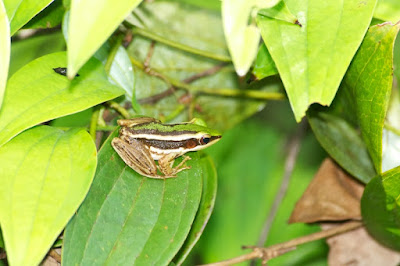
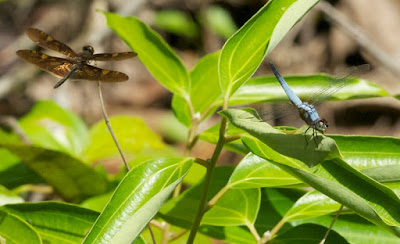


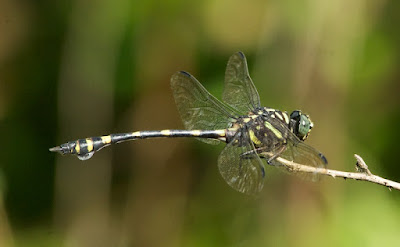











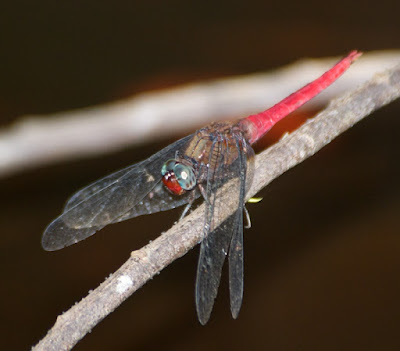
















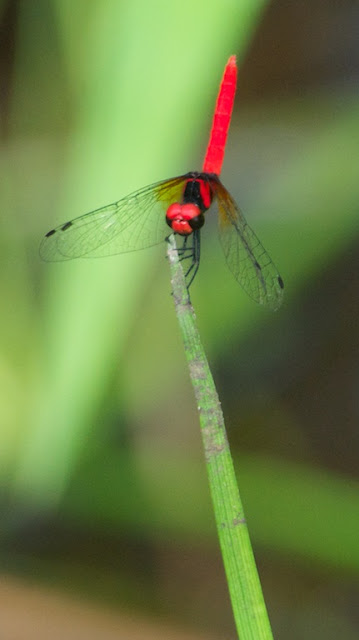



No comments:
Post a Comment